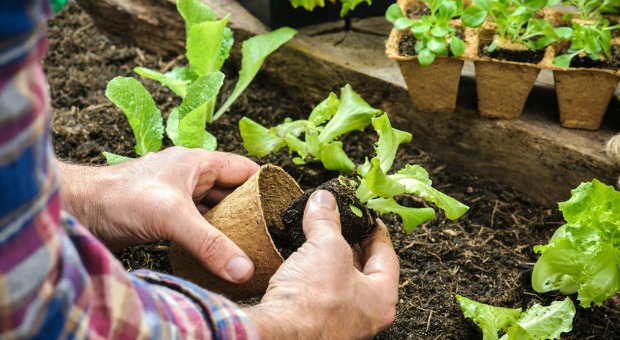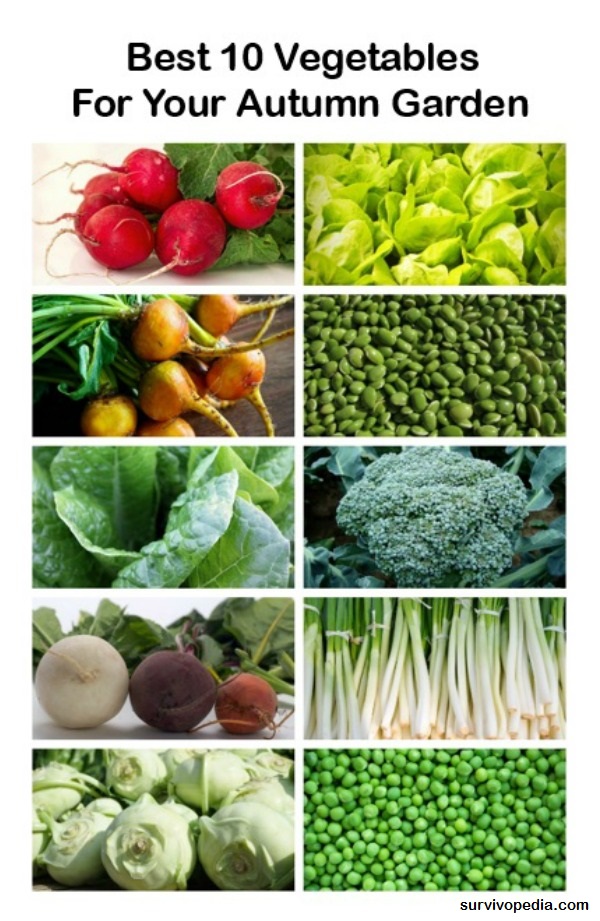The weather is cooling down, at least in my neck of the woods, the pasture is drying up, and fall is in the air.
While autumn may not be associated with gardening as much as other seasons, there’s still plenty you can do.
Depending on the date of your first expected frost, you can still get seeds in the ground to harvest before winter. There are many plants that do better in cooler weather as opposed to the full-sun they’d get in the summer.
Now is also the time to plant crops that stay in the ground all winter to harvest in the spring. Your plants will establish a good root system this fall, which gives you a head start on next year’s garden plans.
10 Quick Growing Plants to Sow Now
These ten plants mature quickly. You can plant them now, and harvest them in mid to late October. Some will keep producing well into November to really extend your fall harvest.
When selecting seeds, be sure to check the package to see how many days until maturity are needed for that particular variety. You’ll want to go with the one that has the shortest length, to ensure your plants are ready to harvest before winter.
- Radishes
- Lettuce
- Beets
- Beans
- Spinach
- Broccoli
- Turnips
- Green onions
- Kohlrabi
- Peas
You’ll notice that greens and root crops make up the bulk of these recommendations. These types of plants typically do well in cooler weather.
Tips for Sowing Seeds in Autumn
The weather should be your biggest consideration before sowing seeds this time of year. You don’t want to lose your plants to a hard frost before you’re able to harvest anything.
If You Expect an Early Frost
Each area has a different growing season, which means you might not be able to grow as long as someone in a warmer climate. You have to know what the weather patterns are in your area.
If you aren’t sure what the autumn weather is like, it’s time to find out. Ask your local county extension agency. Talk to your neighbors who garden. See if your library has books specific to your region.
Once you know when to expect your first hard frost, you’ll be able to plan your autumn garden more efficiently. If your area freezes early, you’ll need to take extra precautions when planting. Otherwise, it’s likely that your plants will die when the cold weather strikes.
You can:
- Plant indoors
- Use a greenhouse
- Create a cover for your plants with wire and plastic
- Use garden fabric to cover plants
- Create cold frames
- Cover plants with blankets
These techniques will help prolong your growing season. You’ll be proactive in fighting the frost instead of just watching your plants freeze.
1. Keep Your Soil Warm
If you live in an area where it doesn’t normally freeze early, you may not need to take as many precautions. One thing you will want to do though, is ensure that your soil stays warm.
Your layers of mulch dutifully kept your soil cooler all summer long. To help keep your soil warm, consider removing this mulch before planting fall crops. That way the soil can suck in as much sunlight as possible.
You might also want to think about using a layer of plastic to trap the heat. You can cut an X in the plastic where each seedling will emerge.
2. Watch the Wind
Is it windy in the autumn where you live? Fighting the wind is hard on plants. Provide a windbreak by:
- Building a fence
- Utilizing existing trees and bushes
- Set up garden fabric over your plants
Mild Winters?
Not every region experiences cold winters. If you live in a zone where temperatures stay above freezing year-round, your garden can thrive throughout the fall.
You won’t be limited to the plants listed above. You’ll be able to grow just about anything, including:
- Okra
- Eggplants
- A variety of peppers
- A variety of winter squash
- Cucumbers
- Potatoes
- Brussels sprouts
- Carrots
- Cauliflower
If you’re area is prone to extremely hot summers, fall may turn out to be your most productive garden season. Your plants won’t be struggling with heat, and can actually spend energy on producing a harvest.
Crops to Start Now for Spring Harvest
In many zones, fall is also the perfect season for starting plants for spring. You’ll need to select hardy plants, that can withstand your area’s low temperatures. Otherwise your plants will die over the winter, instead of simply remaining dormant.
If you grow any perennials in your garden, such as asparagus and rhubarb, you’re already used to the concept of overwintering plants. They grow all year, and then rest over the winter. Then they shoot up in the spring, bursting with newfound energy from the warmth.
Plants that are short and low to the ground tend to do better with overwintering than taller ones. The snow layer that gathers will actually provide a layer of insulation, protecting the young plants.
Why Overwinter Annual Plants?
Planting in the fall allows your crops to get a solid root system developed before winter. Then when the snow melts in the spring and temperatures start to rise, these plants will lowly resume their growth. Fall planted crops will often lead to an earlier harvest in the garden.
The slow growth does have an effect on the plants. Many root crops that are allowed to overwinter are described as being much sweeter than their spring planted varieties.
Here are ten crops to consider adding to your garden this fall with the intention of harvesting in the spring:
- Garlic
- Onions
- Carrots
- Parsnips
- Spinach
- Arugula
- Kale
- Beets
- Winter squash
- Pumpkins
Planting these now will give your garden a great head start in the spring. Just be sure that they have ample time to establish a root base before the harshness of winter sets in. Four to six weeks before your first killing frost is a good reference point for getting seeds in the ground.
If your winters are severe, you may need to offer your young plants protection in the form of row covers. You can either buy ready-made ones, or make your own.
How to Plant Trees in the Fall
Nut and fruit trees are an excellent addition to the garden. Depending on your zone, fall could be the best time of year to add trees to your homestead.
If your area typically experiences mild or moderate winters, you should be alright to plant your trees in September or October. But, you’ll want to ensure they have protection around them.
A layer of mulch or straw will provide excellent insulation. You can use a wire cage to hold this material up to the trunk of your new tree. There are also tree guards you can purchase that’ll protect your tree’s trunk from pests and sun damage.
Fall planting allows your trees to get established before winter. They’ll continue to grow early in the spring, and you’ll be that much closer to having your own fruits and nuts.
However, the extreme cold of some areas of the world are not suitable for young trees. If your ground freezes by mid-October or November, you should wait until spring to plant trees.
How to Plant a Cover Crop
If your soil needs a little boost, you can consider planting a cover crop over all or part of your garden this autumn. Also known as green manure, this crop will return nutrients to your soil. By sowing in the fall, you’ll allow this plant to grow a bit before winter hits.
In the spring, you won’t harvest your crop. Instead, you’ll till the greens back into the soil. Just as plants you harvest nourish your body, cover crops nourish your soil. It’s a natural fertilizer.
Cover crops do more than just feed your soil. They also help keep weeds at bay, control pests, and keep your soil workable.
You’ll want to plant most cover crops at least four weeks before your first hard frost. This will give the roots time to get established before winter arrives.
In the spring, you’ll want to mow this crop before it comes to seed. Use a lawn mower or similar device to cut the cover crop short.
Once it’s short, you’ll be able to till the rest directly into the soil. Plan on doing the tilling a couple of weeks before you plant your garden in the spring. That way the green bits have some time to decompose.
Some cover plants will winterkill in cold climates. That means they won’t grow at all in the spring since the low temperatures at winter will kill them. Many gardeners prefer to grow winterkill cover crops because they are easier to deal with in the spring.
Rather than mowing and tilling live matter, the dead plants will form a thick mulch layer on top of your soil. In the spring, you can rake this away to get down to your refreshed soil.
What to Plant as a Cover Crop?
If you aren’t sure what cover crop to sow, here are some suggestions.
- Rye (either annual or cereal)
- Field peas
- Oats
- Buckwheat
- Clover
- Forage radishes
Your climate and the hardiness of the variety you plant will both play a role in which plants winterkill.
What’s Going in Your Autumn Garden?
I’d love for you to share what you’ll be planting this fall in the comments section below. Will you be planting for harvest in the fall or getting a start on your spring harvest? Are you growing a cover crop on any of your land?
If you share, be sure to let everyone know what zone you’re in so other readers can benefit from your knowledge. After all, there isn’t one right way to garden!
Sharing knowledge is a great way for us all to learn. This is how we’ve learned from our ancestors, and now we want you get this knowledge as well. Click on the image below for more about great survival tips from the old days.
This article has been written by Lisa Tanner for Survivopedia.










Bruce | September 14, 2016
|
AMSOIL : A Premium Full Synthetic Lubricant Supplier